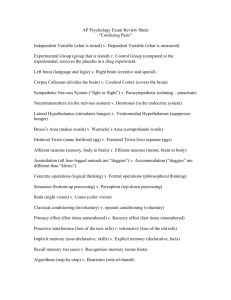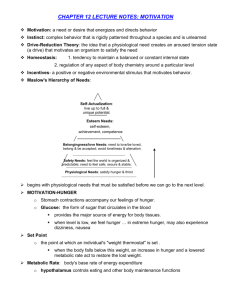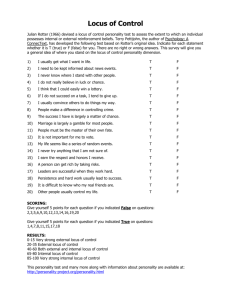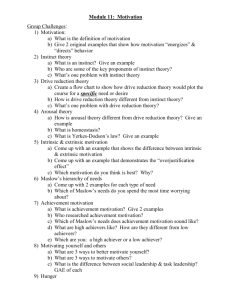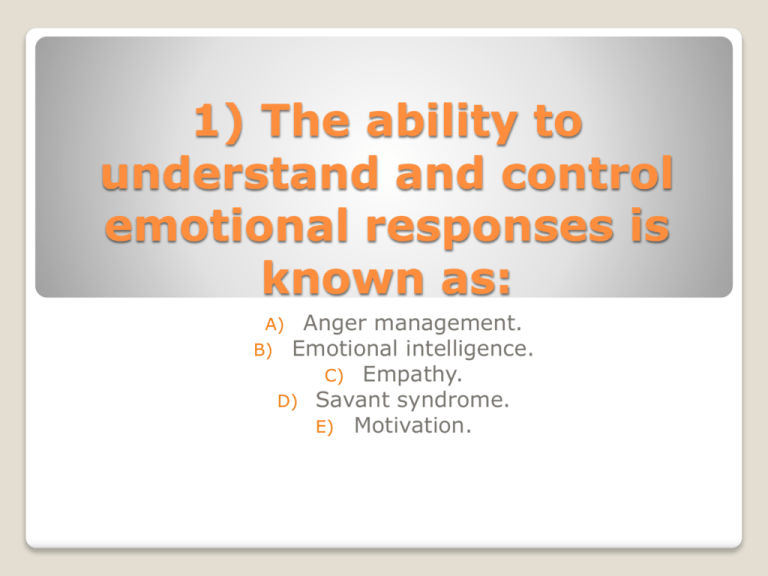
1) The ability to
understand and control
emotional responses is
known as:
Anger management.
B) Emotional intelligence.
C) Empathy.
D) Savant syndrome.
E) Motivation.
A)
2) Goleman reports that,
later in life, the children in
the emotional intelligence
experiment who were
tempted by a marshmallow
but did not eat it
immediately:
Were in more trouble with the law.
B) Could not control their tempers.
C) Were more self-reliant.
Had more trouble getting along with their peers.
E) Has more negative feelings.
A)
D)
How did Murray and
McClelland measure
nACH?
With a polygraph
B) With a Thematic Apperception Test
By measuring achievement related hormones in the
blood.
D) By using grade point averages
E) By using AP tests
A)
C)
4)Which motive seems to
regulate behavior in order to
maintain a certain physical
condition in the body known
as set point?
achievement
B) hunger
C) sex
D) homeostasis
E) All of the above.
A)
5)Selye’s ____suggests that chronic
negative emotional states tend to
produce disease causing changes in
the body, unhealthy behavior patterns,
and poor personal relationships.
Stress Syndrome
B) General Adaptation Syndrome
C) Fight or flight Response
D) General Inhibition Syndrome
E) Alarm Reaction
A)
6) The process of ____
involves starting,
directing, and
maintaining physical and
psychological activities.
Arousal
B) Emotion
C) Drive
D) Motivation
Self-actualization
A)
E)
7) Which of the following
is the best example of a
drive?
Your political views
B) The need for achievement
C) Hunger
Earning money by working at a job
Volunteering time to feed the hungry
A)
D)
E)
8) Our desire to play a
competitive game of golf
is primarily driven by:
Drives.
B) Extrinsic motivation.
C) Motives.
D) Unconscious motivation.
E) Fixed-action patterns.
A)
9) Susan volunteers at the
local grade school to tutor
students who need extra help
in reading. She is not paid,
but she loves to go each
week. Her behavior is an
example of:
Intrinsic motivation.
B) Extrinsic motivation.
Fulfilling a biological need.
D) Fixed-action pattern.
E) Locus of control.
A)
C)
10) _____ theory can
account for regular cycles
of animal activity, such as
the migration of birds or
fish.
Drive
B) Psychoanalytic
C) Instinct
D) Homeostatic
E) The James-Lange
A)
11) Julian Rotter is
known in psychology for
endorsing which
motivation theory?
Drive theory
B) Instinct theory
C) Incentive theory
D) Humanistic theory
E) Social-learning theory
A)
12. Masters and Johnson contributed
to the study of human sexuality by
A)
B)
C)
D)
E)
Interviewing 17,000 Americans about their sexual
behavior.
Directly observing and recording physiological patterns
in sexual behavior.
Developing sexual scripts for sexual responsiveness
Looking for brain abnormalities as the cause of male
homosexuality
Setting up video cameras in peoples homes to
measure their sexual behaviors
13) If you attribute your
success on an exam to
your study habits, you are
using ____ to explain
your performance.
Internal locus of control
B) Extrinsic motivation
C) External locus of control
D) Preconscious motivation
E) Unconscious motivation
A)
14) During hurricane Katrina,
many victims never tried to apply
for federal aid because they
believed that the decision to
receive aid was in the hands of
the government and there was
nothing they as individuals could
do about it. These individuals
have:
A) Negative incentive motivation.
B) An internal locus of control.
C) An external locus of control.
D) Impaired motivation.
E) Extrinsic motivation.
15) According to Freud,
aggression is to Thanatos
as sex drive is to:
Creativity.
B) Libido.
C) Charity.
D) Perception.
E) Drive theory.
A)
Answers
1)
2)
3)
4)
5)
6)
7)
8)
9)
10)
11)
12)
13)
14)
15)
B
C
B
B
E
D
C
C
A
C
E
B
A
C
B

